
|   |

|   |
An interlude: Ramayana at San Antonio, Texas - Dr Sunil Kothari e-mail: sunilkothari1933@gmail.com Photos: Anand September 20, 2009 On receiving an invitation from Bharatanatyam exponent Dr Sreedhara, a disciple of late Guru Narmada from Bangalore, who is now settled in San Antonio since last three years, to see the dance drama Ramayana that he had choreographed, I left on a weekend for San Antonio, Texas on 21st August, 2009. Reaching JFK airport on time, I was told that the flight was delayed for Minneapolis and if I wanted to reach San Antonio by 9 pm, I should take another flight for Memphis, which would bring me to San Antonio in time. I changed the flight as advised. I was waiting in the bus to take us to the aircraft and I heard someone calling me: "Arre, Sunilbhai, where are you off to?" I was pleasantly surprised to see Dr. Sanjay Doddamani. We were both delighted to meet accidentally going to the same destination. He's a doctor but his heart is in classical Indian dance. From a very young age, he was trained in Bharatanatyam in Bangalore, under US Krishna Rao, subtle abhinaya nuances under Venkatalakshamma and later on from Narmada. Grandson of Sudha Rao, and son of former Ambassador Mr. Doddamani, he used to watch his sister study Bharatanatyam and would imitate her. Seeing his natural talent, his parents arranged for his training also. But as often happens in the case of male dancers, they are expected to follow a different career, say of a lawyer, a doctor, or a chartered accountant. So, later on Sanjay studied medicine and there too he proved to be a bright student and today he is a leading Cardiologist in New York. 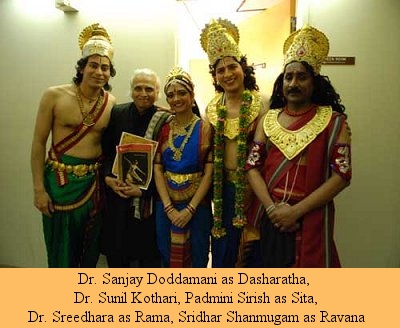 As much as he passionately loves his medical career, he equally loves to dance. Two years ago during a Diwali gathering at Rajika Puri's well appointed apartment in Manhattan, she had invited dancers and musicians. There I met Sanjay, who had at Rajika's request to all artistes to perform brief pieces, rendered a shloka in Bharatanatyam. We had talked briefly and planned to meet at leisure after my return from San Francisco, where I was travelling with Ratan Thiyam and Chorus Repertory Theatre with the play 'Nine Hills One Valley.' We were in a reminiscent mood. On account of bad weather the flight did not take off for another two hours. And later on we were told that we would have to stay overnight at Memphis and take an early flight the next morning to San Antonio. Sanjay took charge of meeting the airline officers, got vouchers to stay at Holiday Inn, the van that would take us to the hotel, got the room and we had red wine and ubiquitous pizza before retiring to bed. Our talks continued recalling various gurus, Bharatanatyam dancers, Protima Bedi, Nrityagram troupe led by Surupa Sen, late Guru Narmada, who was a disciple of Kitappa, and a galaxy of dancers she has trained in Bangalore - and so on and it seemed there was so much to talk about still and time just flew. We called Dr. Sreedhara at San Antonio as Sanjay was taking part as Dasharatha. Another artiste Sridhar Shanmugam, a Bharatanatyam dancer settled in New York, a former member of Chandralekha's troupe, had already reached and was rehearsing with the group in the role of Ravana. From Sacramento, Padmini Sirish, a Bharatanatyam dancer also trained by Narmada was playing the role of Sita. These were the four principal dancers and as Dr. Ramamurthy, a leading doctor from San Antonio told me before the curtain went up, others were the 'Golden Girls of San Antonio.' Thereby hangs a tale. Golden Girls of San Antonio During one of my previous visits to America on a dance lecture tour, a decade ago, I had stayed at Plano, with my friend Dr. Nilendu. His wife ran classes to train dancers in Garba and Raas. I remember having gone to visit the spot where John F Kennedy was shot. In Terrel, Dallas, Revathi Sathyu, (nee Rangachar, daughter of Vimala and Dr. Rangachar from Bangalore) had settled after her marriage with Dr. Neil Sathyu, and was conducting Bharatanatyam classes. Meenakshi Sheshadri had just moved to Dallas and we all met, comparing notes about how Indian Diaspora dancers were establishing their dance academies. Revathi had already established her Arathi School of Indian Dance. Enterprising as Revathi is, she used to visit San Antonio all the way from Terrel regularly and train dancers there and established another school in 1981, which local dancers named also Arathi School of Indian Dance. Among the four dancers, Rajam Ramamurthy, Dr. Malathi Koli, Madhu Mehta and Kamala Rao studied regularly under Revathi and had in no time a large following of local Indian Diaspora young dancers. They celebrated the silver jubilee of their school in 2006, and now they have a sizeable community of a generation of young dancers who practice and perform Bharatanatyam and also folk dances. San Antonio has a number of Indian doctors who have settled there. Rajam married to Dr. Ramamurthy has over the years taken a lead in running the Aarthi School of Indian Dance and other three dancers along with young guru Kausi Subramaniam and with support of Indian community, have done a commendable work for the growth of Bharatanatyam in San Antonio. Rajam had graciously arranged a reception in my honour at her residence, inviting local dancers the next day after the show of Ramayana. It gave me an opportunity to learn about the Indian Diaspora's activities in places like San Antonio, the neighbouring city Austin and of course Houston. But more about it later. Ramayana: The eternal epic Dr. Sreedhara whom I have known for many years as a gifted male Bharatanatyam dancer has also done deep study of Yoga under a disciple of the legendary Yoga master BVK Iyengar. He has combined the study of Yoga and now established Kaveri Natya Yoga at San Antonio, where he conducts special sessions for Yoga and takes classes giving individual attention to dancers studying Bharatanatyam. He has enough experience of choreographing dance dramas, having choreographed in Bangalore, Girija Kalyana, Vikramorvaseeya, Healing Ministry of Jesus Christ, to name a few. He has worked with Maya Rao and imbibed several aspects of choreography with an advantage. Studying under Narmada and for some time also Bhanumathi, he has partnered leading dancers like Swapnasundari, Hema Malini, Prathibha Prahlad and others. For some time he studied abhinaya from Kalanidhi Narayanan, who used to joke, "How do you manage with these prima donnas?" He used to say, "Well, they invite me and I perform!" He is married to Neela Patel, also a doctor, a Gujarati from Bangalore, who has been a great support to his full time activities of dance and Yoga. He performs solo Bharatanatyam and also when invited by other dancers from across USA and Canada, takes lead roles in dance dramas. When another Bharatanatyam dancer from Bangalore, Madhu Manjunath, a disciple of US Krishna Rao and Narmada, now settled in Midlands, planned to have Ramayana produced as a dance drama, she invited Sreedhara. The music was specially commissioned by her from that ace music composer Rajkumar Bharathi, and Sreedhara agreed to choreograph it, because, as he put it, "Ramayana has an eternal appeal." For health reasons, Madhu Manjunath could not take part in the dance drama. She had also written the script and selected the chaupais from Tulasidas's Ramacharitamanasa. Neela suggested that it would be a good idea to involve local dancers with their large number of young acolytes and senior dancers. Rajam Ramamurthy and others welcomed the idea and everyone got involved. For male roles, Sreedhara contacted New York based Sridhar Shanmugam and Dr. Sanjay Doddamani with whom he had worked earlier when Sanjay had presented H2O, a choreographic work after Katrina had struck. Padmini Sirish, a disciple of Narmada and currently completing her Ph. D in Cellular and Molecular Biology at Sacramento, came over to play the lead role of Sita. Sreedhara worked in parts, on the group choreography for Arathi School dancers. A large number of young dancers joined to play various roles as vanar sena, the army of monkeys. Seniors like Rajam Ramamurthy took two / three different roles and also of Hanuman, Malati Koli played the role of Manthara with great success, whereas Madhu Mehta played the role of Vishwamitra. Bana Ramanathan's disciple Swapna Prasad took the role of Lakshmana. Sreedhara said that once the roles were allocated it was easy to work out the choreography for group sequences like setubandha (building of the bridge) by the young dancers who enjoyed all the monkey tricks and danced with glee, and indeed they had a field day. The music was set as mentioned earlier, to the select chaupais of Tulasidas' Ramacharitamanas. Rajkumar Bharathi's handling of several dramatic moments from Ramayana has great emotional appeal. Divided in 10 scenes, the choreography captured the essence of major events. Whoever listens to Dasharatha's promise to Kaikeyi automatically recites along with Dasharatha: 'Raghukula rita sada chali ayi, pran jaye aru vachan na jayi' (O dear Kaikeyi, I give my word to you. You know that we of Raghuvamshis are known for fulfilling the promise we give, even if we have to give our lives, but we shall keep our promise!). And then the heart rending cry of Dasharatha when Kaikeyi asks Bharata to be appointed as King and send Rama to forest for fourteen years - there is hardly anyone in the audience who does not feel the deep anguish of Dasharatha. The secret of the success of this production of Ramayana was its brevity. The story was narrated after each section by Cynthia Macswain, deeply interested in Indian epics and arts, in a manner which made it easy for non -Indian, and mainly more than half of the local American audience to follow the story line. I was impressed by their presence. Kellen McIntyre of Bihl Haus Arts Club, as co-producer with Kaveri Natya Yoga, the organizer in charge of the Jo Long Theatre at Carver Cultural Centre, told me that this was for the first time in the history of their auditorium that more than 500 people had attended the show. The long queue surprised her and the presenters of the show. They had to start the show ten minutes late as there were people filing in to buy the tickets. Kellen's own experience was that Indian dance performances draw majority of Indian audiences only and only a token presence of American public. But the wonder of wonders was the interest shown by local American audience. Some of them had made an effort to study the story well in advance. Kellen's strategy had worked as the local newspapers had carried photos and news about this program, and they were interviewed on the television. Sreedhara had performed a brief solo during the interview. The word of mouth publicity was also helpful and the entire exercise to rope in local dancers and their disciples helped drown petty jealousies, local differences and all worked together in the spirit of a good team, showing confidence in the choreographer's decision and direction. Sreedhara's overview and design, experience and devising scenes in a manner which helped action to move in a seamless manner, was remarkable. A senior American doctor sitting next to me said, "You know, an average American is quite ignorant about the great epics of India. We went to New York to see Phillip Glass's Opera on Bhagvad Gita and were very much impressed. Thanks to Peter Brook, we now know of the Mahabharata. And when we were sent circulars in advance about the Ramayana, some of us decided to read the brief story given to our medical fraternity. We decided to come and also brought other friends. It is a remarkable story and we love the action, dance, costumes, the colours, the spectacle and find it very fascinating." 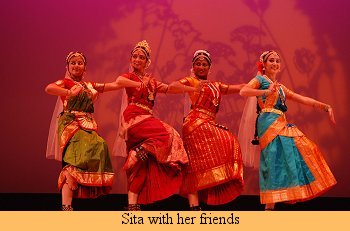 At Jo Long theatre, the co-ordination with the light designer and the person who played the CD of the music, was well synchronized. Few back slide projection, suggesting the Panchavati and forest, the sea when the bridge is built, and in general black background helped the colourful costumes and ornaments to stand out. When Sreedhara as Rama with golden crown, necklace, arm and wrist ornaments and pitambar, yellow dhoti, appeared in full regalia on the stage, along with bedecked Dasharatha with crown and appropriate ornaments, they looked like Suryaputras, descendants of the Sun god. Dr. Sreedhara and Dr. Sanjay Doddamani have an arresting stage presence. When Padmini Sirish dressed in costumes befitting the princess Sita, and Sridhar Shanmugam, twirling his moustache, with the stance of the arrogant demon king Ravana appeared on the stage during the swayamvara - wedding scene - there was a spontaneous applause from the audience. The sequence of Sita playing with her four sakhis in the garden was choreographed imaginatively, all the dancers performing in harmony; the alignment was visually stunning and the charm of youthful maidens was captured in a telling manner. The duet between Rama and Sita was another highlight and both Sreedhara and Padmini Sirish performed Bharatanatyam movements in a captivating manner. Versatile and experienced dancer Sridhar Shanmugam, taking the cue from Padma Subrahmanyam's enactment of Ravana, started twirling his moustache first on the right and then on the left and repeated the movements to suggest many faces of Ravana, the audience applauded for such imaginative touches. Sreedhara had avoided props and ten headed mask for Ravana. Instead the suggestion through hastabhinaya, hand gestures and mukhajabhinaya, facial expressions, created quite an impact. 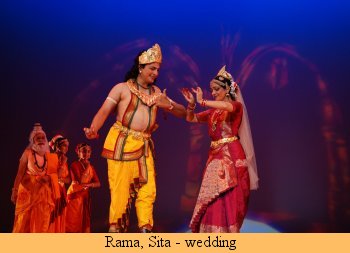
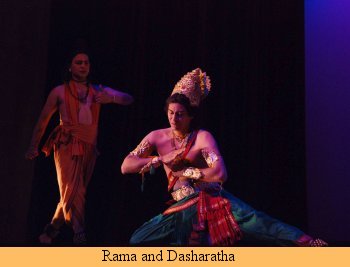
Padmini as Sita, a princess marrying Rama, and later on accompanying him to the forest, in appropriate clothes, and in the final during the coronation of Rama as King, the Mahapattabhishekam, in resplendent costumes, did full justice to her role. Her sound Bharatanatyam training under Narmada is seen during dramatic movements - when she begs Rama to get the golden deer, Lakshmana to go in search of Rama when Rama cries 'Lakshmana, Lakshmana' as Maricha misleads Sita. Or take the sequence of Hanuman visiting her in Ashoka vana, giving her the ring of Rama and parting with the Choodamani to give to Lord Rama; or standing next to Rama in coronation scene - her understanding or the role was perfect. Petite and with charming personality, she carried herself with dignity and in nritta she dazzled. 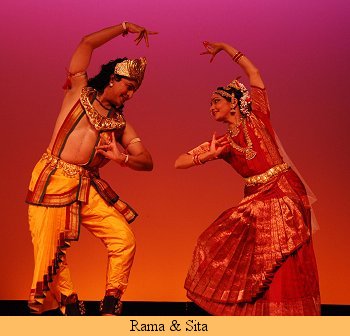
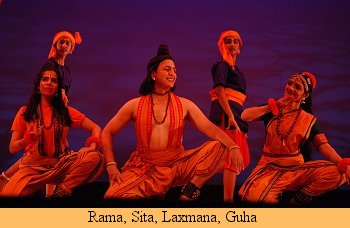
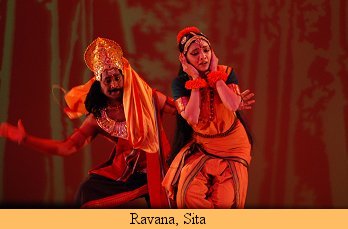
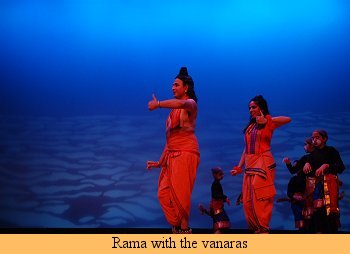
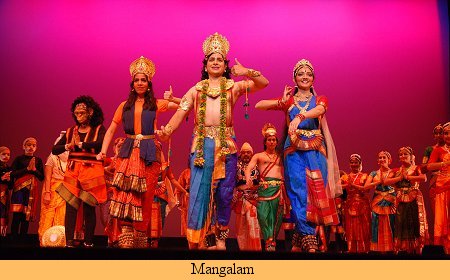 There is no doubt that when an epic like Ramayana with select sequences is taken, its appeal is amazing. The saying in Sanskrit is so true: 'Yavat sthasyanti Giryaha, saritascha mahi tale… Ramasya Katha lokeshu pracharishyati' - Till mountains are on earth and the rivers flow, the story of Rama will continue to captivate the people.  Dr. Sunil Kothari, dance historian, scholar, author, is a renowned dance critic, having written for The Times of India group of publications for more than 40 years. He is a regular contributor to Dance Magazine, New York. Dr. Kothari is a globetrotter, attending several national, international dance conferences and dance festivals. He has to his credit more than 14 definitive works on Indian classical dance forms. Kothari was a Fulbright Professor and has taught at the Dance Department, New York University; has lectured at several Universities in USA, UK, France, Australia, Indonesia and Japan. He has been Vice President of World Dance Alliance Asia Pacific (2000-2008) and is Vice President of World Dance Alliance Asia Pacific India chapter, based in New Delhi. A regular contributor to narthaki.com, Dr Kothari is honored by the President of India with the civil honor of Padma Shri and Sangeet Natak Akademi award. He recently received the Senior Critic award from Dance Critics Association, NYC. |